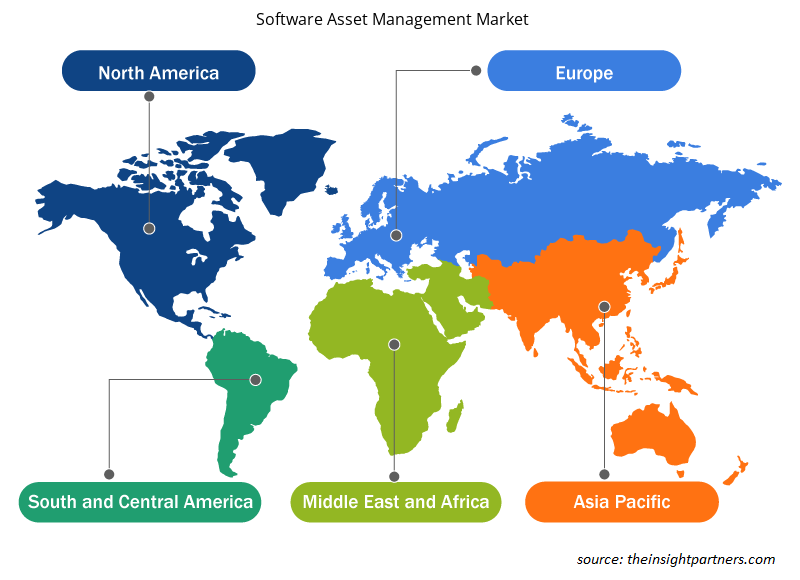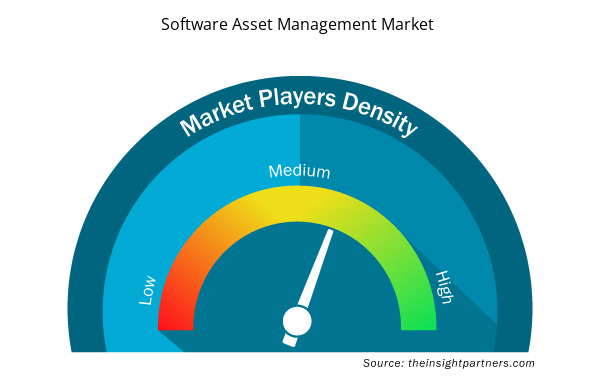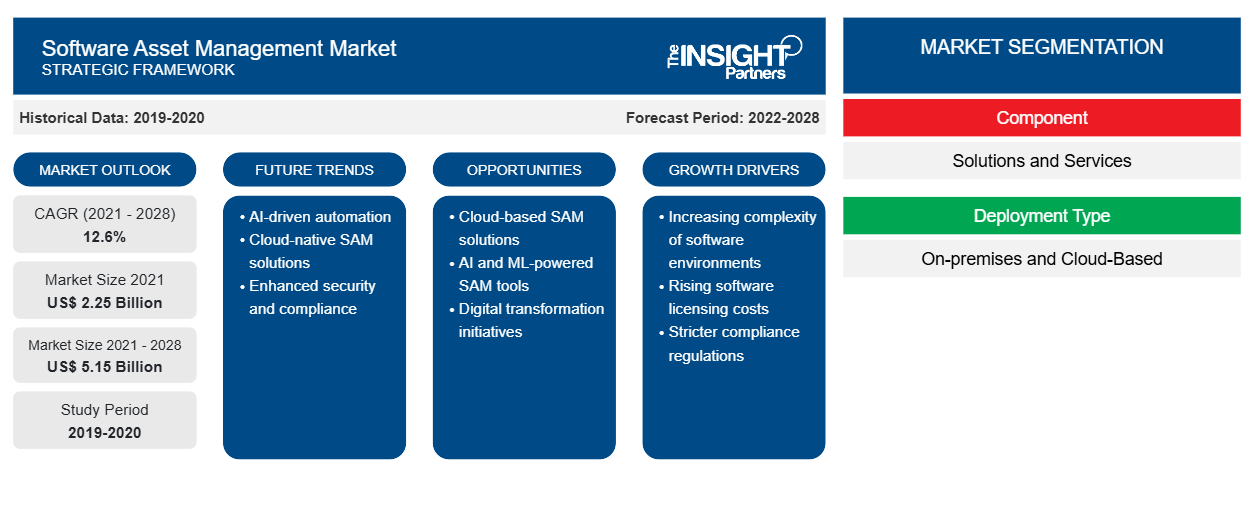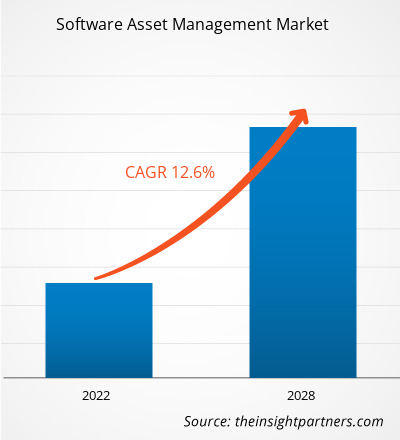[Rapporto di ricerca] Si prevede che il mercato della gestione delle risorse software crescerà da 2.250,37 milioni di dollari nel 2021 a 5.150,51 milioni di dollari entro il 2028; si stima che crescerà a un CAGR del 12,6% dal 2021 al 2028.
L'amministrazione di sistemi, regole e procedure che consentono l'acquisizione, l'implementazione, l'utilizzo, la manutenzione e lo smaltimento di applicazioni software all'interno di un'organizzazione è nota come software asset management (SAM). Il mercato della gestione degli asset software è una componente della gestione degli asset IT che mira a garantire che l'azienda rispetti gli accordi di licenza e non spenda troppo in software. L'identificazione degli asset software, la validità degli accordi di licenza con l'utente finale (EULA) e l'uso appropriato del software libero sono tutti obiettivi cruciali di qualsiasi iniziativa SAM. La documentazione SAM può proteggere l'azienda da cause legali antipirateria, ridurre al minimo l'uso improprio involontario delle licenze e fornire il controllo sul software ombra sulla rete.
La gestione delle risorse software in una grande organizzazione può essere così complicata da richiedere lo sviluppo e la manutenzione di un database che mantenga informazioni su acquisti software, abbonamenti, licenze e patch. Un team come questo è spesso responsabile del rinnovo delle licenze software, della negoziazione di nuovi accordi di licenza e dell'individuazione e rimozione di software raramente o mai utilizzato. Il mercato della gestione delle risorse software verificherà il numero di licenze software acquistate e lo concilierà con il numero di licenze installate per automatizzare il modo in cui le informazioni vengono ottenute da numerose fonti di inventario mobili, desktop, data center e cloud. Gli strumenti SAM possono anche tenere traccia di quante licenze sono rimaste. Per mantenere basse le spese, questa conoscenza può essere utilizzata per eliminare o riassegnare software che non viene utilizzato.
Personalizza questo report in base alle tue esigenze
Riceverai la personalizzazione gratuita di qualsiasi report, comprese parti di questo report, o analisi a livello nazionale, pacchetto dati Excel, oltre a usufruire di grandi offerte e sconti per start-up e università
- Scopri le principali tendenze di mercato in questo rapporto.Questo campione GRATUITO includerà analisi di dati che spaziano dalle tendenze di mercato alle stime e alle previsioni.
Approfondimenti regionali sul mercato della gestione delle risorse software
Le tendenze regionali e i fattori che influenzano il mercato della gestione delle risorse software durante il periodo di previsione sono stati ampiamente spiegati dagli analisti di Insight Partners. Questa sezione discute anche i segmenti e la geografia del mercato della gestione delle risorse software in Nord America, Europa, Asia Pacifico, Medio Oriente e Africa e America meridionale e centrale.

- Ottieni i dati specifici regionali per il mercato della gestione delle risorse software
Ambito del rapporto di mercato sulla gestione delle risorse software
| Attributo del report | Dettagli |
|---|---|
| Dimensioni del mercato nel 2021 | 2,25 miliardi di dollari USA |
| Dimensioni del mercato entro il 2028 | 5,15 miliardi di dollari USA |
| CAGR globale (2021 - 2028) | 12,6% |
| Dati storici | 2019-2020 |
| Periodo di previsione | 2022-2028 |
| Segmenti coperti | Per componente
|
| Regioni e Paesi coperti | America del Nord
|
| Leader di mercato e profili aziendali chiave |
|
Densità degli attori del mercato della gestione delle risorse software: comprendere il suo impatto sulle dinamiche aziendali
Il mercato del Software Asset Management Market sta crescendo rapidamente, spinto dalla crescente domanda degli utenti finali dovuta a fattori quali l'evoluzione delle preferenze dei consumatori, i progressi tecnologici e una maggiore consapevolezza dei vantaggi del prodotto. Con l'aumento della domanda, le aziende stanno ampliando le loro offerte, innovando per soddisfare le esigenze dei consumatori e capitalizzando sulle tendenze emergenti, il che alimenta ulteriormente la crescita del mercato.
La densità degli operatori di mercato si riferisce alla distribuzione di aziende o società che operano in un particolare mercato o settore. Indica quanti concorrenti (operatori di mercato) sono presenti in un dato spazio di mercato in relazione alle sue dimensioni o al valore di mercato totale.
Le principali aziende che operano nel mercato della gestione delle risorse software sono:
- Società Microsoft
- IVANTI
- SOFTWARE PER LA NEVE
- BMC SOFTWARE, INC.
- CERTO
Disclaimer : le aziende elencate sopra non sono classificate secondo un ordine particolare.

- Ottieni una panoramica dei principali attori del mercato della gestione delle risorse software
Mercato della gestione delle risorse software – Profili aziendali
- Società Microsoft
- IVANTI
- SOFTWARE PER LA NEVE
- BMC SOFTWARE, INC.
- CERTO
- FLESSIBILE
- Società IBM
- MICROFOCUS
- SERVIZIOORA
- BROADCOM, INC.
- Analisi storica (2 anni), anno base, previsione (7 anni) con CAGR
- Analisi PEST e SWOT
- Valore/volume delle dimensioni del mercato - Globale, regionale, nazionale
- Industria e panorama competitivo
- Set di dati Excel


- Semiconductor Metrology and Inspection Market
- Webbing Market
- Portable Power Station Market
- Trade Promotion Management Software Market
- Terahertz Technology Market
- Dealer Management System Market
- Educational Furniture Market
- Pressure Vessel Composite Materials Market
- Vaginal Specula Market
- Sleep Apnea Diagnostics Market

Report Coverage
Revenue forecast, Company Analysis, Industry landscape, Growth factors, and Trends

Segment Covered
This text is related
to segments covered.

Regional Scope
North America, Europe, Asia Pacific, Middle East & Africa, South & Central America

Country Scope
This text is related
to country scope.
Domande frequenti
The software asset management market based on component type is segmented into solutions, and services. In 2020, the solution segment held the largest software asset management market share.
SAM helps an organization to decrease software costs, increase compliance, and improve processes for employee software requests. The capability of an entity to replace, update, or enhance the overall skills of the enterprise can become critically impaired. Furthermore, support and managing costs for these critical assets necessarily grow to be a significant inconvenience. The need to follow the organization’s policies, control licensing, and assured security for the internal network, is needed for the enterprise to be successful. Software license management tools are driving the market.
In addition to managing software assets, software asset management (SAM) for cloud settings focuses on cost management, software portfolio management, and regulatory challenges. In cloud settings, where services are provided, configured, reconfigured, and released in a matter of minutes, software asset management (SAM) as a process must adapt to the quick speed of change. The various cloud approaches – Infrastructure as a Service (IaaS), Platform as a Service (PaaS), and Software as a Service (SaaS) – have varying effects on software asset management (SAM), and organizations will need to carefully and proactively consider the impact their cloud strategy has on their software asset management (SAM) programs, in general, and specifically on their software licensing. For instance, Cloud Economics is a periodic comprehensive service that gives clients transparency and control over their Cloud deployment while also assisting them with budgeting, contract renewals, infrastructure changes, mergers and acquisitions, standards, rules, and processes.
On the basis of industry vertical, the global software asset management market is segmented as BFSI, IT and Telecom, manufacturing, retail, and consumer goods, government, healthcare and life sciences, education, media and entertainment, others. Manufacturing segment held the largest software asset management market share in 2020.
IoT-enabled software asset monitoring and analytics solutions leverage web, analytics, and wireless to combine all the traditional solutions, processes, assets, and workflows into a single solution to offer a centralized consolidated tracking and monitoring and analytics system. These systems provide anytime, anywhere access and any device connectivity with enormous scalability and effective IT-OT (information technology systems - operational technology systems) integrations. Companies may utilize IoT-based solutions to keep track of all of their assets, recover and maintain them, identify issue areas, stock inventories, build up a replenishment system, properly evaluate risk and compliance, and analyze asset usage and condition. Business entities will now have the time and resources to evaluate the quality, quantity, and placement of assets to enhance work processes, eliminate waste, and avoid unexpected equipment failure to keep a cost-effective system running, which in turn is likely to gain momentum for the software asset management (SAM) market over the forecasted period.
Based on deployment type, the software asset management is categorized into on-premise, and cloud-based. Cloud segment dominate the market. The increasing utilization of cloud-based services and big data tools is acting as a major growth-inducing factor. Software asset management solutions deployed in the cloud provide web-based management and enterprise-wide protection solutions with increased scalability, network security, and speed.
Trends and growth analysis reports related to Technology, Media and Telecommunications : READ MORE..
The Insight Partners performs research in 4 major stages: Data Collection & Secondary Research, Primary Research, Data Analysis and Data Triangulation & Final Review.
- Data Collection and Secondary Research:
As a market research and consulting firm operating from a decade, we have published and advised several client across the globe. First step for any study will start with an assessment of currently available data and insights from existing reports. Further, historical and current market information is collected from Investor Presentations, Annual Reports, SEC Filings, etc., and other information related to company’s performance and market positioning are gathered from Paid Databases (Factiva, Hoovers, and Reuters) and various other publications available in public domain.
Several associations trade associates, technical forums, institutes, societies and organization are accessed to gain technical as well as market related insights through their publications such as research papers, blogs and press releases related to the studies are referred to get cues about the market. Further, white papers, journals, magazines, and other news articles published in last 3 years are scrutinized and analyzed to understand the current market trends.
- Primary Research:
The primarily interview analysis comprise of data obtained from industry participants interview and answers to survey questions gathered by in-house primary team.
For primary research, interviews are conducted with industry experts/CEOs/Marketing Managers/VPs/Subject Matter Experts from both demand and supply side to get a 360-degree view of the market. The primary team conducts several interviews based on the complexity of the markets to understand the various market trends and dynamics which makes research more credible and precise.
A typical research interview fulfils the following functions:
- Provides first-hand information on the market size, market trends, growth trends, competitive landscape, and outlook
- Validates and strengthens in-house secondary research findings
- Develops the analysis team’s expertise and market understanding
Primary research involves email interactions and telephone interviews for each market, category, segment, and sub-segment across geographies. The participants who typically take part in such a process include, but are not limited to:
- Industry participants: VPs, business development managers, market intelligence managers and national sales managers
- Outside experts: Valuation experts, research analysts and key opinion leaders specializing in the electronics and semiconductor industry.
Below is the breakup of our primary respondents by company, designation, and region:

Once we receive the confirmation from primary research sources or primary respondents, we finalize the base year market estimation and forecast the data as per the macroeconomic and microeconomic factors assessed during data collection.
- Data Analysis:
Once data is validated through both secondary as well as primary respondents, we finalize the market estimations by hypothesis formulation and factor analysis at regional and country level.
- Macro-Economic Factor Analysis:
We analyse macroeconomic indicators such the gross domestic product (GDP), increase in the demand for goods and services across industries, technological advancement, regional economic growth, governmental policies, the influence of COVID-19, PEST analysis, and other aspects. This analysis aids in setting benchmarks for various nations/regions and approximating market splits. Additionally, the general trend of the aforementioned components aid in determining the market's development possibilities.
- Country Level Data:
Various factors that are especially aligned to the country are taken into account to determine the market size for a certain area and country, including the presence of vendors, such as headquarters and offices, the country's GDP, demand patterns, and industry growth. To comprehend the market dynamics for the nation, a number of growth variables, inhibitors, application areas, and current market trends are researched. The aforementioned elements aid in determining the country's overall market's growth potential.
- Company Profile:
The “Table of Contents” is formulated by listing and analyzing more than 25 - 30 companies operating in the market ecosystem across geographies. However, we profile only 10 companies as a standard practice in our syndicate reports. These 10 companies comprise leading, emerging, and regional players. Nonetheless, our analysis is not restricted to the 10 listed companies, we also analyze other companies present in the market to develop a holistic view and understand the prevailing trends. The “Company Profiles” section in the report covers key facts, business description, products & services, financial information, SWOT analysis, and key developments. The financial information presented is extracted from the annual reports and official documents of the publicly listed companies. Upon collecting the information for the sections of respective companies, we verify them via various primary sources and then compile the data in respective company profiles. The company level information helps us in deriving the base number as well as in forecasting the market size.
- Developing Base Number:
Aggregation of sales statistics (2020-2022) and macro-economic factor, and other secondary and primary research insights are utilized to arrive at base number and related market shares for 2022. The data gaps are identified in this step and relevant market data is analyzed, collected from paid primary interviews or databases. On finalizing the base year market size, forecasts are developed on the basis of macro-economic, industry and market growth factors and company level analysis.
- Data Triangulation and Final Review:
The market findings and base year market size calculations are validated from supply as well as demand side. Demand side validations are based on macro-economic factor analysis and benchmarks for respective regions and countries. In case of supply side validations, revenues of major companies are estimated (in case not available) based on industry benchmark, approximate number of employees, product portfolio, and primary interviews revenues are gathered. Further revenue from target product/service segment is assessed to avoid overshooting of market statistics. In case of heavy deviations between supply and demand side values, all thes steps are repeated to achieve synchronization.
We follow an iterative model, wherein we share our research findings with Subject Matter Experts (SME’s) and Key Opinion Leaders (KOLs) until consensus view of the market is not formulated – this model negates any drastic deviation in the opinions of experts. Only validated and universally acceptable research findings are quoted in our reports.
We have important check points that we use to validate our research findings – which we call – data triangulation, where we validate the information, we generate from secondary sources with primary interviews and then we re-validate with our internal data bases and Subject matter experts. This comprehensive model enables us to deliver high quality, reliable data in shortest possible time.


 Ottieni un campione gratuito per questo repot
Ottieni un campione gratuito per questo repot